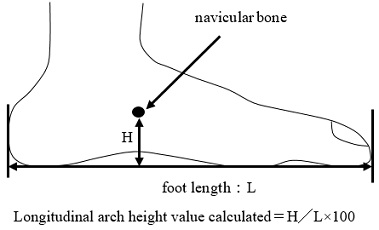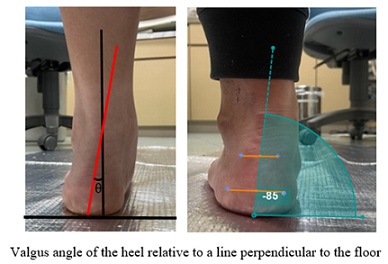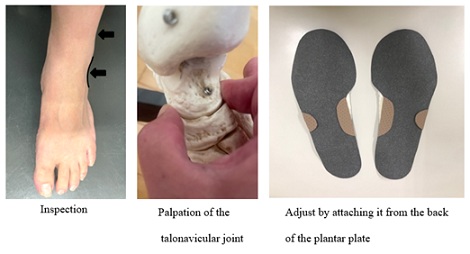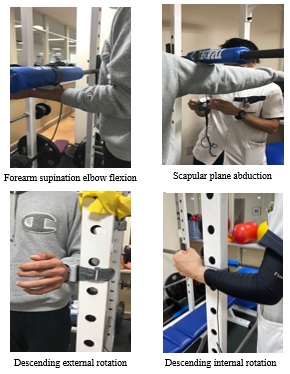
Plantar Plate Increase Upper Extremity Muscle Strength in Patients with Flat Foot
*Corresponding Author(s):
Shingo ShimizuFaculty Of Health, Medical And Welfare, Saitama Prefecural University, Japan
Tel:+81 489734123,
Email:shimizu-shingo@spu.ac.jp
Abstract
It is said that the plantar plate causes a kinetic chain from the foot to the knee joint, hip joint, pelvis, and trunk by correcting the alignment of the foot. In a previous study, a spillover effect of foot alignment correction on scapular function was reported. However, there are no reports on the effect on upper extremity muscle strength. The purpose of this study was to confirm whether the correction of foot alignment with plantar plates can increase upper extremity muscle strength in patients with external flat foot. The subjects were 18 male patients diagnosed with bilateral flat foot. Foot alignment and upper extremity muscle strength (elbow joint flexor, shoulder joint abduction, external rotation, and internal rotation) were measured without and with plantar plates. Foot alignment was significantly corrected and upper extremity muscle strength was increased in all of upper extremity muscle when wearing the foot inserts compared to when not wearing the plantar plates. In the case of the external flat foot, it was assumed that the foot alignment was corrected by wearing the plantar plates, and the foot became stable and easier to obtain floor reaction force. Secondarily, the alignment of the lower limb, pelvis, spine, thorax, and scapula changed, and posture was corrected, making it easier to perform the upper limb functions.
Keywords
Floor reaction force; Foot alignment; Plantar plate; Valgus flat foot; Upper extremity muscle
Introduction
Alignment correction by the sole plate causes a kinetic chain from the foot, moving the knee joint, hip joint, pelvis, trunk, and neck in the correct direction, and stabilizing the joints to prevent injuries [1,2].
Stabilizing the foot can affect not only the lower extremities, but also the upper extremities. Previous studies on the upper extremities have reported the ripple effects of foot alignment correction on scapular function [3,4].
In addition, Luis et al. reported that athletes with a history of surgery on the shoulder and elbow joints on the pitching side of both the pivot and step feet had a higher frequency of flat foot and concave feet than athletes with no history of surgery [5].
Therefore, flat foot may have some effect on the upper limbs. However, the effects of flat foot on upper extremity muscle strength and the effect of plantar plates are currently unknown and no reports have been found.
Therefore, we aimed to confirm whether the strength of the upper extremity muscles can be improved by correcting the alignment of the foot using a plantar plate in patients with flat foot valgus.
Subjects And Methods
Subjects were 18 patients who were diagnosed with bilateral flat foot valgus, had no other history of injury or disability in the lower extremities, and had no trauma, disability, or complaints in the trunk or upper extremities.
The 18 subjects were male, with an average age of 14.7 ± 2.5 years (mean ± standard deviation), an average height of 162.0 ± 11.4 cm (mean ± standard deviation), and an average weight of 58.5 ± 17.3 kg (mean ± standard deviation).
The purpose of the study was fully explained to the subjects, and their informed consent was obtained both verbally and in writing. This clinical study was consulted with the ethics committee and approved (approval number: A-78).
- Methods
Both feet were assessed for medial longitudinal arch and subtalar joint valgus.
For the evaluation of the medial longitudinal arch, we used the longitudinal arch height value calculated by dividing the distance from the floor surface to the navicular bone by the actual foot length when standing still and multiplying the value by 100 [6] (Figure 1). 
Figure 1: medial longitudinal arch height ratio.
In our previous research, the standard value for flat foot was 15.7% or less for men [7].
The varus/valgus evaluation of the subtalar joint was performed using the two-dimensional analysis software kinovea on the images of the bilateral standing position. The angle of inclination (heel angle) was measured [8,9] (Figure 2).The plantar plate was manufactured so that the same examiner could guide the subtalar joint to the neutral position (Figure 3).
 Figure 2: Left heel valgus angle.
Figure 2: Left heel valgus angle.
 Figure 3: Manufactured plantar plate.
Figure 3: Manufactured plantar plate.
The method of evaluating the subtalar joint is to visually check the position where the concave curve lines above and below the lateral malleolus are uniform from the front [10], then palpate the talonavicular joint to confirm the neutrality of the subtalar joint. and fine adjustments was pasted from the back of the plantar plate (Figure 4).
 Figure 4: Fine adjustment of the subtalar joint to neutral
Figure 4: Fine adjustment of the subtalar joint to neutral
After measuring the foot alignment without and with the plantar plate, upper limb muscle strength was measured with and without the plantar plate.
As upper extremity muscle strength were measured elbow joint flexion, shoulder joint abduction, external rotation, and internal rotation on the dominant hand side. Measurement limb positions are standing, elbow joint flexed at 90 degrees and forearm in supination position, shoulder joint abduction at 90 degrees on the scapular plane, shoulder joint external and internal rotation in upper limb hanging position and the elbow joint was flexed at 90 degrees and internal and external rotation was intermediate (Figure 5).
 Figure 5: Measurement of upper limb muscle strength.
Figure 5: Measurement of upper limb muscle strength.
Results
Regarding foot alignment, before installing the plantar plate, the vertical arch height ratio (average ± SD %) was 11.6 ± 2.2% on the right, 11.8 ± 2.3% on the left, and the heel angle (average ± SD degrees) was 7.3± 2.2 degrees on the right, 7.2±1.9 degrees on the left.
However, after installing the plantar plate, the vertical arch height ratio was 16.3 ± 1.0% on the right and 16.3 ± 1.1% on the left, and the heel angle was 1.0 ± 2.0 degrees on the right and 1.1 ± 2.0 degrees on the left. It changed significantly to the foot alignment was induced to the correct position (Table 1).
|
|
Before installation |
After installation |
|
Right longitudinal arch height value (%) |
11.6±2.2 |
16.3±1.0* |
|
Left longitudinal arch height value (%) |
11.8±2.3 |
16.3±1.1* |
|
Right heel valgus angle (deg) |
7.3±2.2 |
1.0±2.0* |
|
Left heel valgus angle (deg) |
7.2±1.9 |
1.1±2.0* |
Table 1: Foot alignment (mean ± standard deviation).
*:p < 0.05
The upper limb muscle strength measurements (mean ± standard deviation N) were as follows before installing the plantar plate, elbow flexion was 173.7 ± 48.4N, scapular abduction was 120.4 ± 42.1N, external rotation in descending position was 78.9 ± 33.1N and internal rotation in descending position was 80.8 ± 29.6.
However, after installing the plantar plate, the elbow flexion was 191.4 ± 55.6N, scapular abduction was 139.8 ± 48.5N, descending external rotation was 90.1 ± 30.5N, and descending position was internal rotation 93.3 ± 36.9N. Upper limb muscle strength significantly increased when wearing the plantar plate compared to when not wearing it (Table 2).
|
|
Before installation |
After installation |
|
Forearm supination elbow flexion (N) |
173.7±48.4 |
191.4±55.6* |
|
Scapular plane abduction (N) |
120.4±42.1 |
139.8±48.5* |
|
Descending external rotation (N) |
78.9±33.1 |
90.1±30.5* |
|
Descending internal rotation (N) |
80.8±29.6 |
93.3±36.9* |
Table 2: Upper limb muscle strength (mean ± standard deviation.
Consideration
This time, as a result of comparing the muscle strength of elbow joint flexion, shoulder joint scapular plane abduction, descending external rotation, and descending internal rotation when plantar plates were not attached and when plantar plates were attached, all muscles were improved when plantar plates.
The reason for this is that this time, we are targeting valgus flat foot in which the subtalar joint is valgus, so first, the foot alignment is corrected by installing a plantar plates, and the transverse tarsal joint due to valgus subtalar joint The soft foot caused by the parallelization of the (calcaneocuboid and talonavicular) joint axes was corrected and became stiff, making it easier to obtain ground reaction force.
Second, the subtalar joint is induced to invert and become neutral, which changes the alignment of the lower limbs, pelvis, spine, thorax, and scapulae, and corrects posture, making it easier to exert muscle strength in the upper limbs. It was thought.
However, since this study does not evaluate the posture qualitatively or quantitatively, it is only speculation.
The fact that upper limb muscle strength was improved by installing a plantar plates that guided the subtalar joint into neutrality for flat foot may be used to prevent diseases of the upper limb muscles.
In particular, prevention of re-tear after shoulder joint rotator cuff surgery and It can be expected to be effective in preventing upper extremity muscle damage. A limitation of this research is that posture was not evaluated, and we would like to continue this research as a future issue.
Conclusion
We investigated the effects on upper limb muscle strength of 18 patients diagnosed with bilateral valgus flat foot by plantar plates that guided the subtalar joint in a neutral direction.
As a result, the muscle strength of elbow joint flexion, shoulder joint scapular abduction, descending external rotation, descending internal rotation was significantly increased after the plantar plate was installed compared to before the plantar plate was installed.
Conflict of Interest
There are no conflicts of interest in this research conflict of interest.
References
- Sasaki K (1998) Plantar plate therapy for foot disorders, orthopedic athletic rehabilitation practice manual. All Japan Hospital Publishing Association, 139-149.
- Iritani M (1994) Ankle and foot disorders. Physical therapy 21: 508-512.
- Hara T, Suzuki K (2017) Ripple effects on the pelvis and scapula by wearing insoles for flat foot. 52nd Annual Conference of Physical Therapy in Japan 44: 1.
- Yamagishi S, Sakaguchi Y, Nishimura A (2011) Effects of excessive foot pronation correction on scapular alignment. 46th Japanese Physical Therapy Congress Abstracts 38: 1 -72.
- Feigenbaum LA, Roach KE, Kaplan LD (2013) The Association of Foot Arch Posture and Prior History of Shoulder or Elbow Surgery in Elite-Level Baseball Pitchers. Journal of Orthopaedic & Sports Physical Therapy 43: 814-820.
- Okubo M, Shimazu A (1989) Examination of the method for measuring foot arch height in medical checks. Clinical Sports Medicine 6: 336-339.
- Shimizu S, Kato Y (2009) Reliability of footprint and arch height ratio values for flat feet. Clinical Biomechanics 30: 243-248.
- Okubo M (1995) Heel eversion and disability. Joint Surgery 14: 85-93.
- Shimizu S, Hanamura H, Sahashi M, et al. (2009) Relationship between pronation and pronation of the hindfoot in medial type knee osteoarthritis and hallux valgus deformity. Shoe Medicine 22: 7-10.
- Iriya M (2001) Foot and ankle joints. Theory and techniques of orthopedic physical therapy. Medical View Publishing 36-61.
Citation: Shimizu S, Gotou S, Kuwabara M, Iwahori Y (2024) Plantar Plate Increase Upper Extremity Muscle Strength in Patients with Flat Foot. J Altern Complement Integr Med 10: 490.
Copyright: © 2024 Shingo Shimizu, et al. This is an open-access article distributed under the terms of the Creative Commons Attribution License, which permits unrestricted use, distribution, and reproduction in any medium, provided the original author and source are credited.

